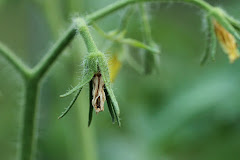Front Range gardeners most commonly associate transplants with warm season vegetables such as tomatoes planted the end of May. Transplants are also useful in the spring, cool season garden for many of the same reasons.
The mid-March to mid-May period of cool spring weather is short. Planting out transplants as soon as soil and air temperatures allow enables you to mature crops before weather warms in May. This extends your cool season and maintains quality.
One family of plants best transplanted rather than direct seeded into the spring garden is the
Brassicas or cabbage family. If broccoli and cabbage plants are large enough and exposed to several weeks of cold (under 50 degrees), they will produce flower stalks.
It is better to start broccoli and cabbage transplants in warmth indoors and plant them outside in mid-April when sustained periods of cold weather are less likely but temperatures are still "cool". It is a tricky concept to grasp.
Broccoli generally does well for gardeners here and if you have never grown it, the superior flavor far exceeds supermarket purchased heads. Early to mid-March is the time to plant seed to grow a 4 to 5 week old transplant ready for early to mid-April planting in the garden.
The photo shows seed of the Burpee broccoli variety 'Sun King' seeded to grow transplants. It's a 71 day variety new in 2013 that is advertised as having unrivaled heat tolerance, a useful trait in our area where warm days can come early. Did anyone living in Colorado's Front Range try it last year and what were your results?
Cabbage likewise grows well here and can be transplanted in the same manner. Cauliflower is much more sensitive to any cultural factor (temperature changes, moisture fluctuations, fertility, insect attack) and is a challenge to grow. Brussels sprouts are longer season plants best planted mid-summer for fall harvest on the Front Range. The spring cool period generally isn't long enough to grow them before hot weather sets in.
Note that most of the
Brassica crops are perhaps easier grown as fall rather than spring crops on the Front Range. However they are worthwhile planting in your spring garden as well as later for fall crops.
Photo credit: Seeded broccoli transplants - Carl Wilson






